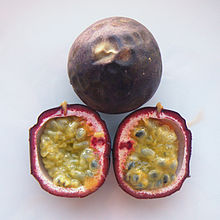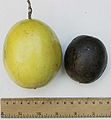Historia
esta planta es de origen tropical, los frutos presentan un sabor intenso y agridulce, muy apreciado en los países norteamericanos, europeos y asiáticos que lo demandan con gran interés. esta posición coloca a Colombia en una posición de privilegio como país productor y exportador de uno de los mejores jugos y concentrados del mundo. esta fruta tiene una gran importancia por las cualidades gustativas de sus frutos y por las cualidades fármaco dinámico y alimenticio de su jugo, cascara y semillas.
Características
El maracuyá es una fruta tropical de una planta que crece en forma de enredadera y que pertenece a la familia de las passiflora, de la que se conoce más de 400 variedades, esta planta es originaria de Brasil pero en nuestro país se han cultivado ambas formas de maracuyá como: (la purpura o morada edulis sims, y la amarilla edulis flavicarpa degenera), aunque la más extendida ha sido la amarilla.
Su jugo es ácido y aromático; se obtiene del arílo, tejido que rodea a la semilla, y es una excelente fuente de vitamina A, niacina, inflacionaria y ácido ascético.La cáscara y las semillas también son susceptibles de emplearse en la industria, por los componentes que tienen.
La pasiflora es una planta que es cultivada en suelos profundos, en donde su uso de semillas debe ser cuidadosamente seleccionadas para su alta productividad, como es el caso de la maracuyá amarilla. Por lo general estas semillas son germinadas en bolsas plásticas, para posteriormente llevarlas al campo cuando cumplan una medida aproximada de 25 cm.
Producto
Con esta fruta podemos obtener diferentes productos como: refrescos, yogures, enlatados, néctares, mermeladas, licores, helados etc.
A continuación te vamos a enseñar un vídeo donde podrá encontrar los pasos a seguir para hacer un postre de maracuyá.
Uses in different countries
In Australia and New Zealand, where it is called "passionfruit", it is available commercially both fresh and tinned. It is added to fruit salads, and fresh fruit pulp or passion fruit sauce is commonly used in desserts, including as a topping for pavlova (a regional meringue cake) and ice cream, a flavouring for cheesecake, and in the icing of vanilla slices. A passionfruit-flavoured soft drink called Passiona has also been manufactured in Australia since the 1920s.

In Brazil, the term maracujá applies to passion fruit (maracujá azedo, or "sour") and granadillo (maracujá doce, or "sweet"). Passion fruit mousse is a common dessert, and passion fruit pulp is routinely used to decorate the tops of cakes. Passion fruit juice, ice pops and more recently soft drinks are also very popular. When making caipirinha, it is usual to use passion fruit instead of lime; it is then called maracujá. It is used also as a mild sedative, and its active ingredient is commercialized under several brands, most notably Maracugina.

In Colombia, it is one of the most important fruits, especially for juices and desserts. It is widely available all over the country and three kinds of "maracuyá" fruit may be found.
In the Dominican Republic, where it is locally called chinola, it is used to make juice and Fruit preserves. Passion fruit-flavoured syrup is used on shaved ice, and the fruit is also eaten raw, sprinkled with sugar.
In Indonesia, there are two types of passionfruit (local name: markisa), white flesh and yellow flesh. The white one is normally eaten straight as a fruit, while the yellow variety is commonly strained to obtain its juice, which is cooked with sugar to make thick syrup. Bottles or plastic jugs of concentrated syrup (generally produced in Sumatra from fruit grown in the Lake Toba region[citation needed]) are sold in many supermarkets. Dilution of one part syrup to four (or more) parts water is recommended.
In Israel, passion fruit is used to make fruit wine.[citation needed]

In East Africa, passion fruit is used to make fruit juice and is commonly eaten as a whole fruit.[8]
In Mexico, passion fruit is used to make juice or is eaten raw with chilli powder and lime.
In Paraguay, passion fruit is used principally for its juice, to prepare desserts such as passion fruit mousse, cheesecake, ice cream, and to flavour yogurts and cocktails.

In Peru, passion fruit is used in several desserts, especially cheesecakes. Passion fruit juice is also drunk on its own and is used in ceviche variations and in cocktails, including the Maracuyá Sour, a variation of the Pisco Sour.
In the Philippines, passion fruit is commonly sold in public markets and in public schools. Some vendors sell the fruit with a straw to enable sucking out the seeds and juices inside. It is not very popular because of its sour flavour, and the fruit is very seasonal.

In Portugal, especially the Azores and Madeira, passion fruit is used as a base for a variety of liqueurs and mousses.
In Puerto Rico, where the fruit is known as "parcha", it is used in juices, ice cream or pastries.

In South Africa, passion fruit, known locally as Granadilla (the yellow variety as Guavadilla), is used to flavour yogurt. It is also used to flavour soft drinks such as Schweppes' "Sparkling Granadilla" and numerous cordial drinks. It is often eaten raw or used as a topping for cakes and tarts. Granadilla juice is commonly available in restaurants. The yellow variety is used for juice processing, while the purple variety is sold in fresh-fruit markets.
In Sri Lanka, passion fruit juice, along with faluda, is one of the most popular refreshments. Passion fruit cordial is manufactured both at home as well as industrially by mixing the pulp with sugar. There are many cordial manufacturers, suppliers and exporters in the country.[9]
In Thailand, passion fruit is called "saowarot" (Thai: เสาวรส). The fruit is eaten whole and is also commonly juiced and drunk. Young shoots are cooked in curries or eaten with nam phrik.[citation needed]
In the United States, it is often used as an ingredient in alcoholic beverages[10][11] and juice mixes.
In Hawaii, passion fruit is called lilikoi and comes in yellow and purple varieties.
Passion fruit can be cut in half and the seeds scooped out with a spoon. Lilikoi-flavoured syrup is a popular topping for shave ice. It is used as a dessert flavouring for malasadas, cheesecakes, cookies, ice cream and mochi. Passion fruit is also favoured as a jam or jelly, as well as a butter. Lilikoi syrup can also be used to glaze or marinade meat and vegetables.[12] Most passion fruit comes from backyard gardens or is collected from the wild. While it may be found at farmers' markets throughout the islands, fruits are seldom sold in grocery stores.
In Vietnam, passion fruit is blended with honey and ice to create refreshing smoothies.
In Cambodia, passion fruit is called "machu bey-darch", and the plant vine grows in the wild. Bushes hang with green to yellow round fruits, measuring from 2.5 cm to 4 cm when ripe. This wild variety of passion fruit tastes slightly different but is still quite sour.
In India, the government of Andhra Pradesh started growing passion fruits in the Chintapalli (Vizag) region forests to make them available to the local people. The fruit is found in the jungles of Assam and is known to local people as "lota bel".
In Costa Rica, it is known as "Estococa". The fruit grows in the wild and it is commonly used for juice. It is considerably smaller than the Maracuyá.
No hay comentarios:
Publicar un comentario